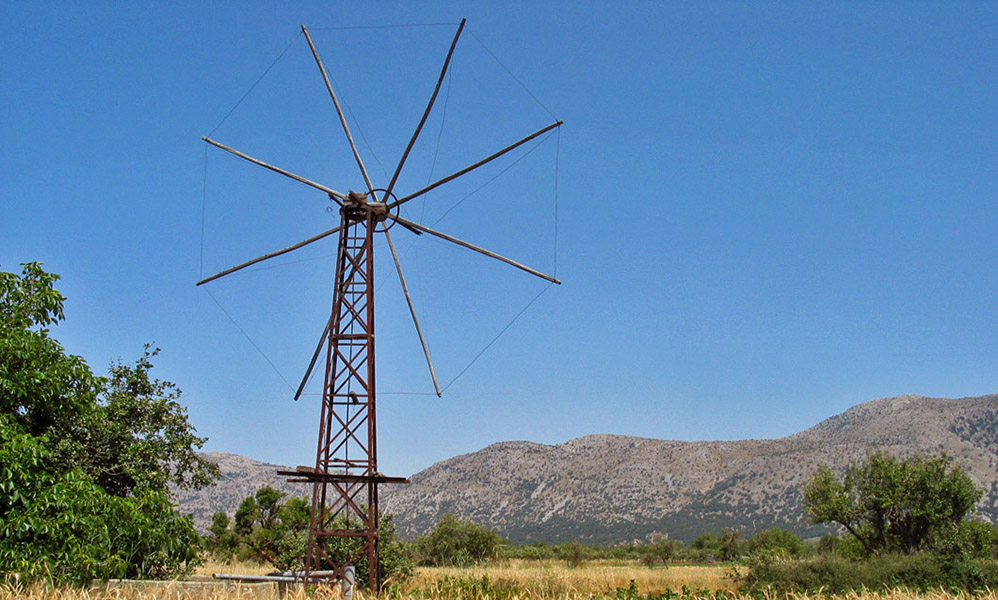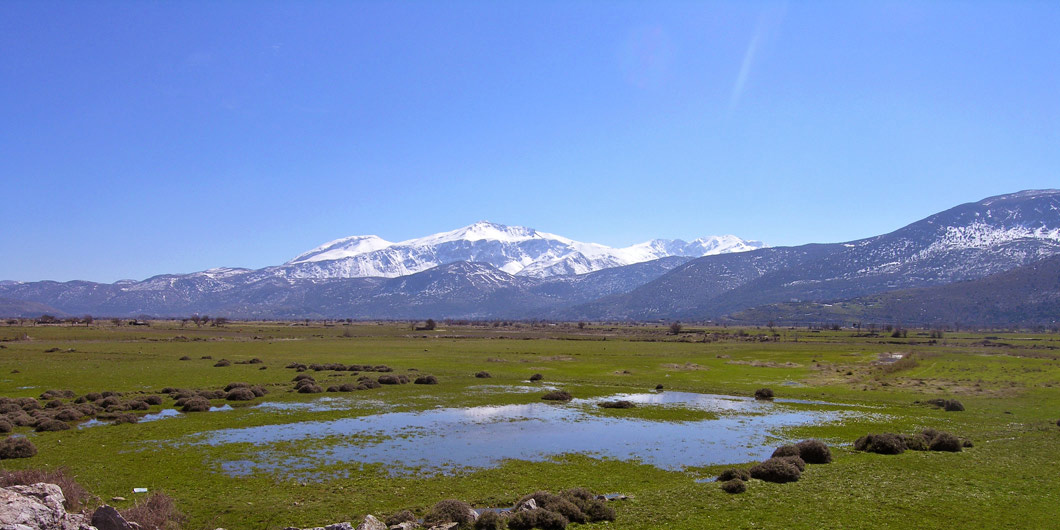At an altitude of 850 m, the Lasithi Plateau is the largest mountain plain in Crete – and the only one occupied all the year round.

Roughly ovoid, it runs some 11 km east-west by 6 north-south. Surrounding it are the peaks Selena (1559 m) at the north, Afendi (1588 m) and Louloudaki (1163 m) west, Spathi (2148 m) to the south and Katharo (1564 m) and Varsami (1545 m) to the east.
Animal-rearing and agriculture were the main occupations in the past.
Today this huge polje of the Dikte massif has been transformed into a giant garden. Up to a few years ago irrigation was managed by thousands of small windmills.
In a way it was a massive wind-farm – in a traditional form and pumping up water, not producing electricity.
Human settlement here is very old. The Dictean cave, above Psychro, is where – according to legend – Zeus was raised.

Neolithic and Minoan finds are quite extensive: for instance, a major burial cave (EM-MM) at Aghios Charalambos, settlements of the palatial times and later are known at Papoura (northwest of Lagos village) and at Plati not far from the Cave.
The British (eg. Evans and Pendlebury) explored and excavated sites on the hills and peaks around: Karfi par excellence, from the end of the Bronze Age. Typically they were unfortified, but in positions of arduous access; mayhap later Venetian forts were built on such earlier ruins.
After 600 BC the Papoura settlement developed significantly, opening up new suburbs: it became a flourishing city down to the Roman period. Under the Byzantines life continued to flourish: right down to 1211 when it passed into Venetian control. The great rebellions of the Agiostefanites, of the Psaromelingoi and of the Kallergidoi were all centred on Lassithi. That is why the Venetians regarded it as the ‘thorn in the heart of Venice’.
In 1263 the Venetians evicted the residents, uprooted trees and forbad grazing in the region: it remained deserted for two hundred years!
Then in 1463 Venice rented out the plain for wheat production – they needed to feed their navy and army. They carried out works and cut drainage channels – the so-called linies – to tackle the standing waters; the area was divided up into blocks (still visible today). The descendants of the original inhabitants began to return to the area, which bit by bit revived.

After the conquest of the Peloponnese by the Turks, the Venetians transferred refugees and settled them on the plain, Where they remained... until the Turks took Crete: Lassithi passed into their hands, but once more became a centre of resistance.Today around the edge of the plain stand 17 villages: from the north entrance, and clockwise after Pinakiano are Lagos, Tzermiado, Farsaro, Marmaketo, Aghios Konstantinos, Mesa Lassithi, Mesa Lasithaki, Aghios Georgios, Koudoumalia, Avrakonte, Kaminaki, Magoula, Psychro, Plati, Aghios Charalambos and Kato Metochi.
Many of the inhabitants migrate for the winter months to villages in the area of Herakleion, returning in the Spring. The main occupation is agriculture still, with the addition of handicrafts and tourism.
The Linies
These are channels dug in the 15th century on by the Venetians to drain the plain: they were created because of the Venetian need for flat and fertile land to grow wheat on. Because of the length of time the plain had been deserted, it had become swampy.
To improve matters, the Venetians dispatched skilled engineers to plan and open up the first ditches – the linies as they are today called – to drain the water in the winter months. There are 12 such on a N-S axis, equally spaced, and 20 orientated W-E, closer together and not equidistant.


















